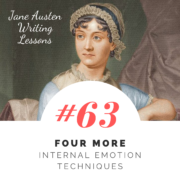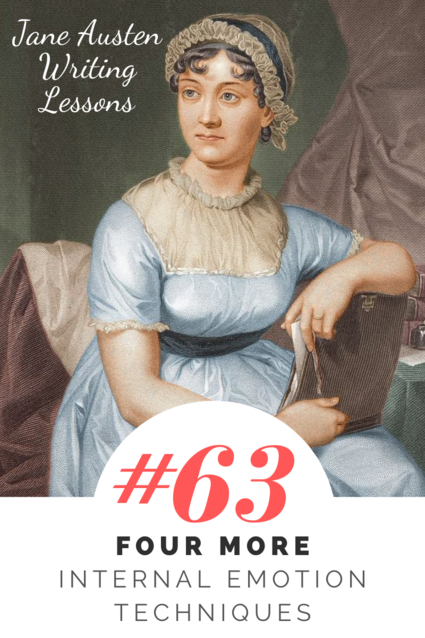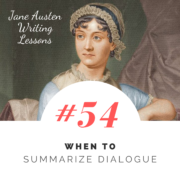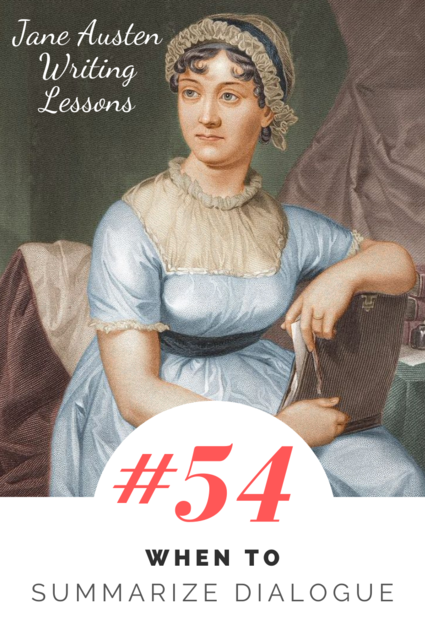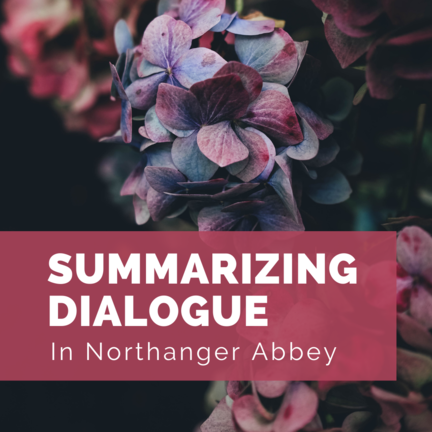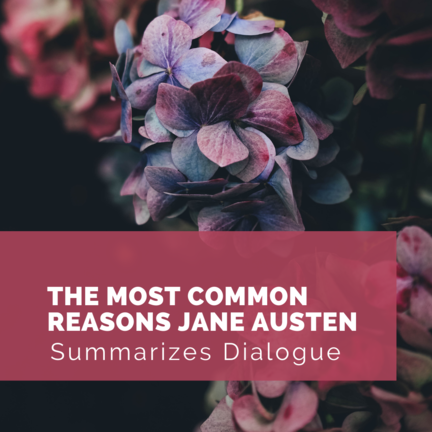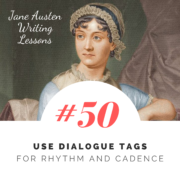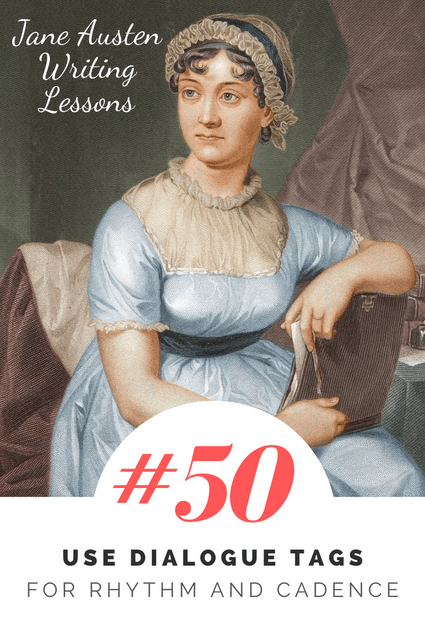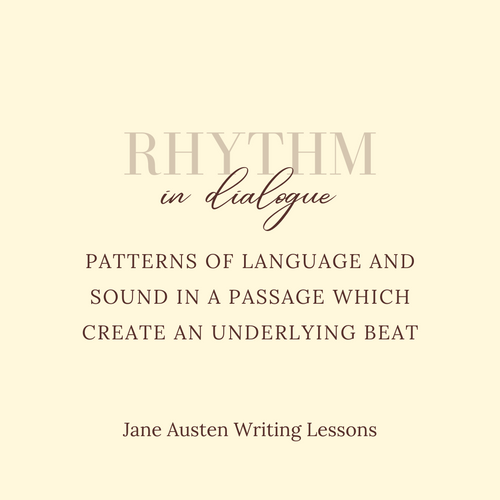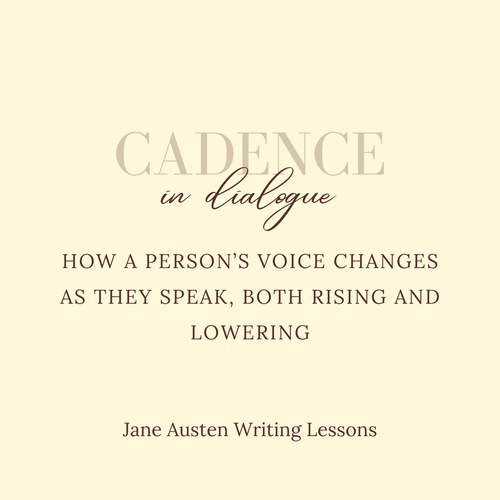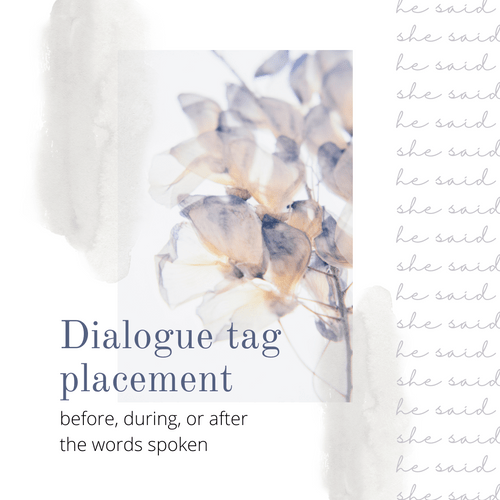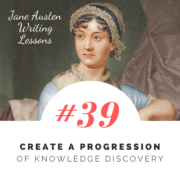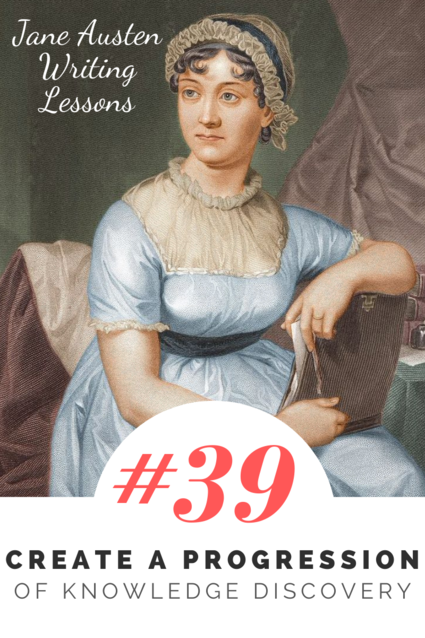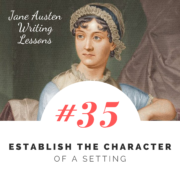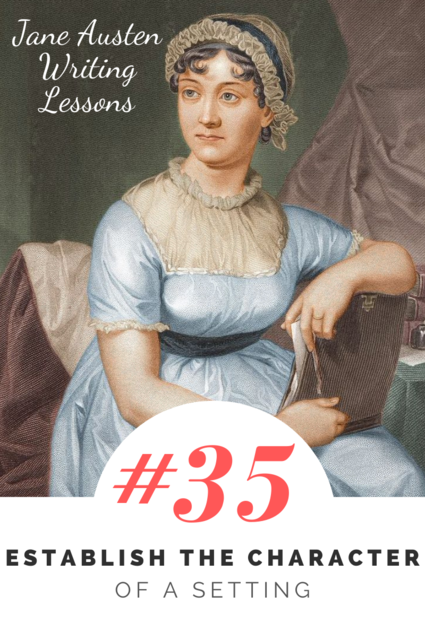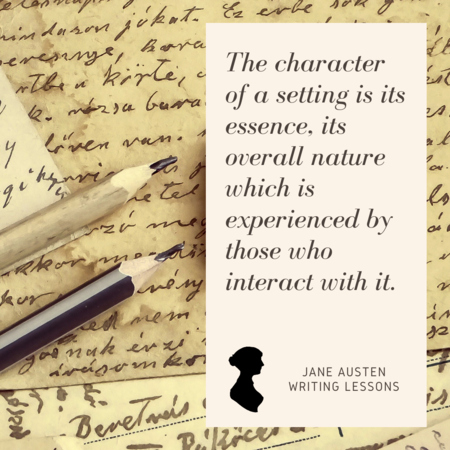#63: Four More Internal Emotion Techniques
In Jane Austen’s novel, Northanger Abbey, the character of Catherine Morland is filled with emotions, so much so that she is sometimes carried away in flights of fancy. Austen uses many of the techniques we’ve already talked about to plant clues to her emotional state, including sharing character thoughts, free indirect speech, relationship to setting as a window into emotion, concrete actions and behavior, awareness/lack of awareness, body language, verbs and adjectives, and dialogue.
There are four more key techniques that Jane Austen uses to convey emotion. These techniques work best for viewpoint characters, because they often require being in the character’s head. They are tools that can be applied for both very emotive characters, like Catherine Morland, and for characters that keep their emotions more concealed, subdued, and in check, like Elinor Dashwood in Sense and Sensibility.
Additional Internal Emotion Techniques (which are especially useful for viewpoint characters
- Punctuation, Syntax, and Rhythm
- Pointing to the past and/or to the future
- Repetition
- Physical sensation and internal physical sensation
We’ll consider two scenes from Northanger Abbey that demonstrate these four internal emotion techniques.
Internal Emotion Technique 1: Punctuation, Syntax, and Rhythm
Punctuation, syntax, and rhythm can be a powerful tool for conveying emotion, especially when the punctuation, syntax, and rhythm are markedly different from other sentences, passages, or scenes.
In Northanger Abbey, Catherine has met many new acquaintances. In particular, she has fallen for a certain Henry Tilney, and she has also become friends with Henry’s sister, Eleanor.
Eleanor wants a companion, so she and her father, General Tilney, invite Catherine to come stay with them at their home, Northanger Abbey. The narrator then gives us a sense of Catherine’s reaction. Take note of the punctuation, the syntax, and the rhythm that is employed:
Northanger Abbey! These were thrilling words, and wound up Catherine’s feelings to the highest point of ecstasy. Her grateful and gratified heart could hardly restrain its expressions within the language of tolerable calmness. To receive so flattering an invitation! To have her company so warmly solicited! Everything honourable and soothing, every present enjoyment, and every future hope was contained in it; and her acceptance, with only the saving clause of Papa and Mamma’s approbation, was eagerly given. “I will write home directly,” said she, “and if they do not object, as I dare say they will not—”
Note the heavy use of exclamation marks, the short sentences and other phrases that build with rapid commas, and the way that the rhythm builds to match her excitement.
Exclamation marks and commas aren’t the only punctuation marks Jane Austen employs to convey emotion—at other points in her novel she uses em dashes, question marks, and periods in revelatory ways. Long and short sentences, sentences with broken rhythm and smooth, sentences which feel like poetry—all of these are tools Austen uses to impact the reader’s experience of the character’s lived experience.
In a prior post, I analyzed Emma’s large discoveries near the end of the novel Emma. These discoveries show her that she has been wrong in so many ways, and this realization impacts her emotions. If you reread those passages, you see that punctuation, syntax, and rhythm are constantly in play to help us understand Emma’s experience.
While punctuation, syntax, and rhythm are especially useful at conveying the emotion of the viewpoint character, they can also be used to for non-viewpoint characters, but typically only in their dialogue. (We have no way of knowing their internal thoughts, but the way the punctuation, syntax, and rhythm of how they speak can definitely be effected by their emotions.)
Internal Emotion Technique 2: Pointing to the Past and/or the Future
In a previous lesson, we talked about how we can access a viewpoint character’s thoughts on a subject, and this can be used to reveal emotion. This technique is an extension of that. An extremely effective way to reveal emotion is to have a character think of something that happened in the past or in the future.
Past events can be ones which we experienced earlier in the novel. Pointing again to them creates emotional resonance between those events and the new passage. It can show the character creating meaning or connection, for good or for bad. It can recall prior emotions, or reinterpret past emotions into something new.
You can also point to past events that did not occur in the novel—that happened before the pages. This provides backstory, it paints a fuller picture of the character’s lives, and it can also illuminate why something might impact a character in a certain way.
The next passage is a little later in the same scene, after the Tilneys have invited Catherine to visit Northanger Abbey. In this passage, Catherine looks back on all her experiences in Bath, even the ones that were not always positive (some of the scenes with her friend Isabella were rather fraught) in a rosy light, as leading to this moment. How she is analyzing and calling upon the past gives a strong sense for her present emotional state.
The circumstances of the morning had led Catherine’s feelings through the varieties of suspense, security, and disappointment; but they were now safely lodged in perfect bliss; and with spirits elated to rapture, with Henry at her heart, and Northanger Abbey on her lips, she hurried home to write her letter….By the kindness of her first friends, the Allens, she had been introduced into scenes where pleasures of every kind had met her. Her feelings, her preferences, had each known the happiness of a return. Wherever she felt attachment, she had been able to create it. The affection of Isabella was to be secured to her in a sister. The Tilneys, they, by whom, above all, she desired to be favourably thought of, outstripped even her wishes in the flattering measures by which their intimacy was to be continued.
The paragraph continues by pointing to the future. Catherine immediately begins imagining and envisioning what her experience at Northanger Abbey might look like.
She was to be their chosen visitor, she was to be for weeks under the same roof with the person whose society she mostly prized—and, in addition to all the rest, this roof was to be the roof of an abbey! Her passion for ancient edifices was next in degree to her passion for Henry Tilney—and castles and abbeys made usually the charm of those reveries which his image did not fill. To see and explore either the ramparts and keep of the one, or the cloisters of the other, had been for many weeks a darling wish, though to be more than the visitor of an hour had seemed too nearly impossible for desire. And yet, this was to happen. With all the chances against her of house, hall, place, park, court, and cottage, Northanger turned up an abbey, and she was to be its inhabitant. Its long, damp passages, its narrow cells and ruined chapel, were to be within her daily reach, and she could not entirely subdue the hope of some traditional legends, some awful memorials of an injured and ill-fated nun.
Pointing to the future is a powerful tool to convey emotion, because it can reveal what a character expects, what they hope for or fear, whether they are high strung or analytical or relaxed. A character has no way of knowing what the future will actually hold, but how they think about the future reveals their current state.
Once again, this is a tool that is largely used for viewpoint characters.
Internal Emotion Technique 3: Repetition
Repetition is a powerful tool. Jane Austen uses repetition of action, of thought, of imagery, of attention, of words, and of certain sounds. You can repeat anything, as long as it creates a building sensation.
Repetition can connect things together. It shows what the character is focusing on, what their thoughts can’t avoid, what they keep coming back to. It can create rhythm, it can call back to something from earlier, or it can further develop an emotion or thought.
In the previous scene, we already saw the repetition of the word every (emphasis added):
Everything honourable and soothing, every present enjoyment, and every future hope was contained in it.
Later, when Catherine is at Northanger Abbey, she has a frightening night in her bedroom, partly because she has convinced herself that frightening things have happened in this space.
She wonders what is in an old-fashioned cabinet, and throughout the scene, she tries to open it again and again—a repetition of action. There is also a repetition of her experiencing the wind. Some characters might notice that it’s stormy, and it’s mentioned once, but in this scene, wind is mentioned again and again, and each time it shows the building of her emotions.
The window curtains seemed in motion. It could be nothing but the violence of the wind penetrating through the divisions of the shutters; and she stepped boldly forward, carelessly humming a tune, to assure herself of its being so, peeped courageously behind each curtain, saw nothing on either low window seat to scare her, and on placing a hand against the shutter, felt the strongest conviction of the wind’s force.
A little later in the scene we read:
The wind roared down the chimney, the rain beat in torrents against the windows, and everything seemed to speak the awfulness of her situation.
And again:
A violent gust of wind, rising with sudden fury, added fresh horror to the moment.
Later still:
She had not been used to feel alarm from wind, but now every blast seemed fraught with awful intelligence.
And one final reference to the wind:
The storm still raged, and various were the noises, more terrific even than the wind, which struck at intervals on her startled ear.
In early drafts, I sometimes include unneeded repetition. I’ll accidentally repeat a word or a phrase, I’ll start too many sentences in the same way, or I’ll have a character do the same thing twice for no reason. I always try to cut the accidental repetitions. The intentional repetitions can be powerful, though I always test them on readers to make sure my use of repetition is building something rather feeling like sloppy writing.
There is a myriad of ways you can use repetition for viewpoint characters. For non-viewpoint characters, repetition is most likely to be seen either in their dialogue or the in repeated actions.
Internal Emotion Technique 4: Physical sensation and internal physical sensation
For viewpoint characters and non-viewpoint characters alike, a character’s actions, behavior, and body language are a strong indicator of their emotions. Does a character drop a letter, walk slowly, run up the stairs, or fidget restlessly? Each of these can be an outward expression of their internal state.
For viewpoint characters, we can also use their physical sensations—things happening to their body—and their internal physical sensations—things happening inside the body that other characters cannot possibly know.
The following paragraph is from the scene with the wind, while Catherine is trying to open the cabinet. I’ve bolded a sentence that reveals Catherine’s physical sensations.
It was some time however before she could unfasten the door, the same difficulty occurring in the management of this inner lock as of the outer; but at length it did open; and not vain, as hitherto, was her search; her quick eyes directly fell on a roll of paper pushed back into the further part of the cavity, apparently for concealment, and her feelings at that moment were indescribable. Her heart fluttered, her knees trembled, and her cheeks grew pale. She seized, with an unsteady hand, the precious manuscript, for half a glance sufficed to ascertain written characters
Catherine is feeling her heart flutter. Her knees are trembling. And her cheeks are growing pale. Each of these physical sensations are her body’s manifestations of her emotion.
Her heart fluttering is a truly internal physical sensation. It is inside her body, and it effects and reflects her experience when she finally manages to open the cabinet.
Her cheeks growing pale is also a physical sensation, though it has an external component that other characters could notice, were they in the room. Her knees trembling is a physical sensation that would be rather unlikely for other characters to notice, but possible in certain situations.
Regardless, these are all physical sensations belonging to our viewpoint character that are part of her experience and are fair game for the narrator to mention.
If you want a resource on how to write about internal and external physical sensations, as well as body language and actions that might reflect certain emotions, I highly recommend the book The Emotion Thesaurus.
While some authors rely heavily on physical sensation and internal physical sensation to convey emotions, Jane Austen uses it sparingly. However, when she uses it, she does so to great effect.
Conclusion
There are so many tools that can be used to convey a character’s emotions. For viewpoint characters, we have the additional opportunity to submerse ourselves into their emotions, by using tools that aren’t as readily available to use on non-viewpoint characters, such as internal physical sensations, repetition, pointing to the past or future, and syntax.
In the next lesson we’ll look at the size or degree of emotions—the differences between conveying small, medium, and large emotions. I hope that you’ll join me!
Exercise 1: Chart your own physical sensations
Over the course of a day or a morning, record your own physical sensations and internal physical sensations. Did you touch something scratchy? Did something taste sour? Did the chair feel hard? Did your knee itch? Did your eyes feel unfocused? Did your back hurt? Did you lose your balance?
If relevant, jot down a word or two that captures your emotional state at the time. Was your physical sensation reflecting your emotions at the time? Did your physical sensations contrast your emotions? Did your physical sensations and internal physical sensations change your emotions?
Consider what you learned about physical sensations and emotions, and how you can incorporate that into your own writing.
Exercise 2: Finding a Place to Live
Write a brief scene in which a character is touring apartments or other places to live. In this scene, try to incorporate each of the techniques talked about in this lesson:
- Punctuation, Syntax, and Rhythm
- Pointing to the past and/or to the future
- Repetition
- Physical sensation and internal physical sensation
Exercise 3: Emotion Revision
Take a scene in a story you are writing and see if you are incorporating any of these techniques. If so, are there ways you could strengthen your use of the technique? If not, at what points would one or more of these techniques be useful? Now revise the scene.

